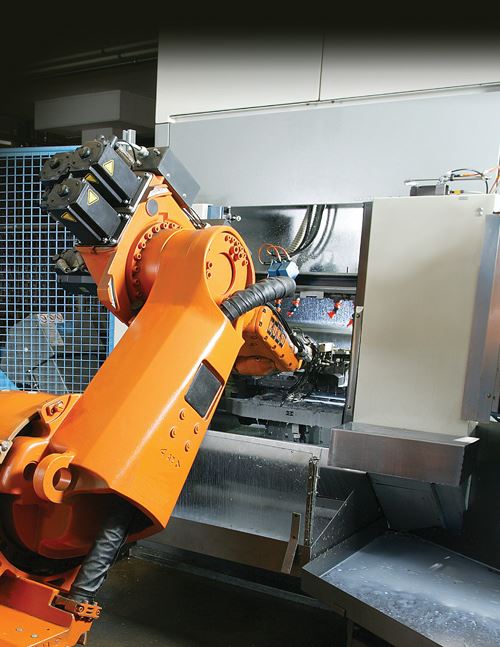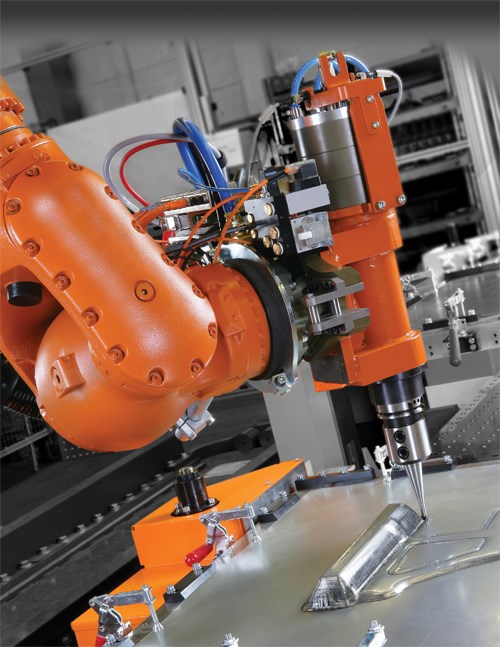Passivation Basics
What is commonly referred to as "passivating" on a shop floor is actually just enhancement of a naturally occurring process on most stainless steels.
What is commonly referred to as "passivating" on a shop floor is actually just enhancement of a naturally occurring process on most stainless steels. Typically used for applications where picture-perfect finish is critical and contamination may cause performance failure, the process provides a two-in-one: cosmetically pleasing surface and top-of-the-line performance. Medical device finishing (think implants and surgical tools) as well as aerospace components are top candidates, but so are everyday items like the stainless steel cutlery found in your kitchen.
When there's a risk of contamination on or corrosion of the stainless steel surface, the passivation process eliminates the risk by forming a chemically inert passive surface layer or film (thereby reducing the reactivity of the steel), which occurs when the stainless steel is exposed to an oxygen environment.
The success of this natural passive film formation can be compromised, however, by contaminants (dirt, oils, grease, compounds, scale) and by the presence of free iron on the part surface. So an organized shopfloor passivation process is designed to remove these contaminants and produce clean, corrosion-resistant stainless steel parts.
Minimizing the potential for contamination and corrosion on stainless steel parts and devices can be critical for safety and performance and is often required in industries such as aerospace and medical devices, among others.
The Passivation Process
In all cases, cleaning is the first step in the passivation process, although in some shops the cleaning may take place in a separate process line or cell. The type of cleaning required depends on the contaminants, the soil loading, the degree of cleanliness required, and the part geometry. Cleaning to remove deposited contaminants such as dirt and grease may involve swabbing, vapor degreasing, spray, or immersion with or without ultrasonics and/or agitation. The cleaning chemistry or detergent should be appropriate for the type of soil to be removed and should be handled in accordance with safety and environmental regulations. If descaling (removal of heavy oxide films from heat treating or welding, or heat tint) is necessary, pickling or electropolishing followed by thorough rinsing may be required, and subsequent passivation with nitric or citric acid may not be indicated (Need specifics? Refer to ASTM A380 and B254).
In a multiple station immersion passivation line, the process often begins with one or more cleaning tanks equipped with ultrasonics and filtration, possibly agitation or indexed rotation (if part geometry or soil loading suggests this would help), and a water-based cleaning chemistry or detergent. Parts should be arranged in baskets, fixtures, racks or indexing equipment to optimize solution contact with all critical surfaces in each step, even in the case of complicated part geometries.
Immediately after the cleaning station, there are one or more rinse stations, which again, may be equipped with mechanical actions such as ultrasonics, agitation, indexing, and/or spray off to facilitate good rinsing. Counter-flow rinsing techniques and automatic make- up devices help maximize water use, conservation and consistency.
Nitric or Citric?
Following the cleaning steps, the acid stage of the passivation process involves controlled contact between the cleaned stainless steel parts and the diluted nitric or citric acid according to one of several possible recipes defined in specifications such as ASTM A967 and AMS2700C. The purpose of this step is to remove any free iron and foreign contaminants that remain after completion of the previous cleaning and rinsing steps.
When possible, the passivation step involves full immersion of the parts in a passivation bath. The bath should be large enough to allow for solution movement around and throughout the load, which can be further enhanced with recirculation and/or ultrasonics. Make sure all equipment associated with the passivation step is compatible with the selected acid.
Acid concentration, bath temperature and contact time are all proportionate in the passivation recipes and are critical to successfully achieving specifications. These process parameters can be monitored either manually or automatically in systems that are so equipped, and long-term data storage is available.
Nitric acid has been the traditional acid of choice for this passivation step, although both ASTM A967 and AMS2700C allow for the use of citric acid. In recent years, citric acid has gained ground because it's friendlier than nitric acid in terms of safety and environmental considerations. It can also produce shorter cycle times. Citric acid passivation is generally considered acceptable as long as it meets stipulated specifications and the buyer's requirements, including successful passivation test results. Some shops are even expanding their capabilities by setting up passivation lines that have both nitric and citric passivation tanks followed by dedicated rinses.
Regardless of which acid is designated, chemistry-appropriate equipment (both personal protective and process) should be used during the process, and handling, storage, and disposal of the selected acid must be in accordance with federal, state, and local regulations.
Thorough Rinsing
The passivation bath is followed immediately by one or more rinses—spray, immersion or a combination—depending on specifications, part geometry and water conservation philosophy. Again, more rinses set up to counter-flow provide superior rinsing and, at the same time, conservation. Sometimes a neutralization step (such as 5% sodium hydroxide) or a post-treatment step (typically sodium dichromate) may also be indicated, again followed immediately by rinsing. The final rinse should be fed with "clean water," with deionized (DI) or reverse osmosis (RO) water being good choices to prevent spotting. Rinsed parts are immediately dried. In scenarios where particle counts are critical, the dryer can be outfitted with a high efficiency particulate air filter (HEPA), or the whole process can be conducted in an appropriate class clean room setting.
Passivation Equipment
The optimum equipment for batch immersion passivation is a manual or automated process line consisting of a continuous series of tanks. Lot volumes and throughput requirements influence tank size as well as the number of process stations recommended to meet production goals. The number of required processes also impacts the number of process stations. A continuous automated line, for example, may feature cleaning, pickling, and passivating in one line, each with dedicated rinses, with PLC controlled programs for each process and parallel or random operation as desired. A number of safeties including push-pull exhaust, enclosures, light curtains, and secondary containment are also available, as well as statistical process control, bar coding, and data management.
Passivation Success
Successful passivation is typically determined by inspection and testing. Once passivating is finished, and the parts are rinsed and dried, they should be completely free of surface defects. Pitting, etching, frosting and staining would all be indicative of the possible presence of free iron. Post-passivation, parts can be tested for free iron as required by the specifications or purchaser to verify passivation success. These tests can include water immersion, high humidity, salt spray, or copper sulfate, among others, performed in accordance with ASTM A967 and/or AMS2700C.
Related Content
Anodizing for Bonding Applications in Aerospace
Anodizing for pre-prep bonding bridges the gap between metallic and composite worlds, as it provides a superior surface in many applications on aluminum components for bonding to these composites.
Read MoreHow to Address Declining Powder Coating Coverage Over Time
Fine particles from reclaim could be to blame for powder coating problems that emerge over time. Avoid problems by keeping hooks clean, maintaining guns and using reclaim powder quickly to avoid accumulation of fines.
Read MoreTop Reasons to Switch to a Better Cleaning Fluid
Venesia Hurtubise from MicroCare says switching to the new modern cleaning fluids will have a positive impact on your cleaning process.
Read MorePrevent Plating Problems with Critical Inspections
Tanks and their contents should be regularly inspected visually and analytically. When a quality issue arises, it is important to quickly pinpoint where the main problem is by checking which parameter is out of line.
Read MoreRead Next
A ‘Clean’ Agenda Offers Unique Presentations in Chicago
The 2024 Parts Cleaning Conference, co-located with the International Manufacturing Technology Show, includes presentations by several speakers who are new to the conference and topics that have not been covered in past editions of this event.
Read MoreDelivering Increased Benefits to Greenhouse Films
Baystar's Borstar technology is helping customers deliver better, more reliable production methods to greenhouse agriculture.
Read MoreEducation Bringing Cleaning to Machining
Debuting new speakers and cleaning technology content during this half-day workshop co-located with IMTS 2024.
Read More














.jpg;maxWidth=300;quality=90)







